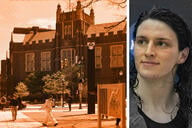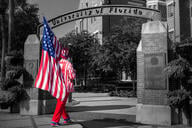You have /5 articles left.
Sign up for a free account or log in.
Tom Bensky was frustrated.
The physics professor at California Polytechnic State University, San Luis Obispo, had tried every way he could think of to take attendance efficiently in his large classes. He used a good old-fashioned sign-in sheet. He attempted a bar code system, where he would scan students on their way out of the classroom. Both were too time-consuming and students would forget to mark themselves present.
Then, Bensky realized he had missed something. He could rely on a tool that most college students had practically welded to their hands: a smartphone. The result of this revelation was a new mobile application and website Bensky created that tracks students’ attendance using their cellphones’ GPS.
His product, which he created last year, is relatively lightly used, with just a couple hundred other professors and officials signing up, but Bensky said he’s gotten positive feedback. He’s also heard the concerns about privacy one might expect about a system that follows a student’s location. Students in his classes must use the app.
“That’s probably my biggest email dialogue with people,” Bensky said of his skeptics. “But I can’t convince them that I’m not going to do anything with the data I’m getting. It’s just the app, server and a database, but it is hard to convince people.”
The service works like this -- a professor (or a coach) signs up on the website youhere.org. The application is free to download, but after a certain number of student uses, the faculty member has to pay $20 for a year.
The user plots on a map where students are allowed to check in for attendance. For professors, this is most likely the part of the building where they hold classes, Bensky said. But Bensky has seen others such as coaches mark the center of a swimming pool or field. The space is usually narrow enough that someone couldn't just be in the building and sign in without being present in class.
Once students enter this radius, a “geofence,” they push a button on the app noting that they’ve arrived for class. The app, reading students’ cellphone GPS, won’t permit them to check in if they’re still slumbering in their dormitory or chowing down in the dining hall.
Students only have a certain amount of time to do this. Bensky said he’s set his system so students can check in five minutes before class begins and then up to 20 minutes after it starts. But users can adjust this window to their liking, he said. A professor can take students’ attendance manually if they forget their phones, Bensky said.
Bensky said he tries to limit the data he collects. He only keeps the students’ first and last names (not just his own) on a server that also includes the number of times they’ve checked in. He can also view the areas that his users have designated for check-ins. But Bensky stressed he doesn’t store any information about where his or any other students are on campus. He said he would be fascinated to research where students are when they miss class, but said “it would be too creepy.”
“I don’t know that,” Bensky, referencing students’ locations. “It would be interesting to study, interesting to see where they are when they are absent, but no.”
An instructor must choose to clear the data after the class has ended. Bensky plays no role in that, he said.
Cal Poly spokesman Matt Lazier said he was unaware of the app until a reporter contacted him. Later, he said the university has no connection to the app and he could not provide comment.
Universities already collect an extraordinary amount of information, said Alan Rubel, an associate professor in the Information School and Center for Law, Society and Justice at the University of Wisconsin at Madison. When students use campus internet, their unique IP addresses are visible to administrators who can track what they're browsing, Rubel said. When they check in at the gym or at a dining hall, students typically use a card reader that tells a university what they're doing and who they're doing it with. The sort of attendance system Bensky has created is another form of surveillance. Generally, officials should be scrutinizing how much they are invading students' privacy.
Rubel also said that students could be downloading an app that does more than its publicly stated purpose (Rubel said he does not believe this is the case).
"It's often unknown, the quality or the usefulness of the information," Rubel said. "Sometimes we're just collecting information because we can, and students have claims to privacy."
Since he started the project last summer, Bensky has had about 200 people -- professors, coaches and others -- sign up, and during peak times during the academic year, about 5,000 to 8,000 students nationwide check in daily.
Bensky said he has paid for an advertisement for the service to appear on certain Google searches with the keyword “attendance,” for instance, but said it’s pricey, and he could easily spend $100 or $150 a day.
He’s also got competition. A company called Course Key offers similar check-ins through GPS or QR codes. The service was first created in 2015 and developed at the Zahn Innovation Platform Launchpad, an entrepreneurial center associated with San Diego State University. Its founders were frustrated by the significant number of students who would miss large classes every day, said Hannah Zwick, the director of special projects at Course Key. While the company has heard concerns around privacy, it assures its customers that the service tracks students only when they're checking in, Zwick said. The GPS and other forms of attendance taking are used on more than 90 campuses, both two- and four-year institutions, she said.
Professors who want to use the service charge students for it, between $25 and $65, depending on whether they want Course Key access just for a semester or a lifetime, Zwick said. Two-year institutions typically pay for all their students to use the services, between $8 and $11 per month per student, and then also pass on the costs to the students.
Top Hat, a student engagement platform that was founded a decade ago as an alternative to that remote-control clickers were being used in classrooms to take attendance, identifies several flaws with GPS-based attendance.
First, locations can be easily spoofed on a cellphone. Students can download other applications that allow them to fake their position, a loophole that Bensky acknowledges but said that “would require a computer science geek to put in some effort.”
And GPS locations on phones are not always accurate, which could lead to students not being able to check in even when they’ve attended class. Top Hat does not mention any privacy concerns.
Some institutions, such as at the University of Nevada, Las Vegas, have also attempted Bluetooth-based systems. In this case, a professor installs a beacon, which picks up when a student is nearby and records their attendance. Bensky said he considered this option but found the range wasn’t large enough.
“For me, this is remarkable,” Bensky said. “I can walk into my class, welcome the class and say something like, ‘Don’t forget to check in, and then it just happens. I can just walk back to my office and take attendance for 65 check-ins, see who wasn’t here. No pencils, no roster, no check boxes.”




